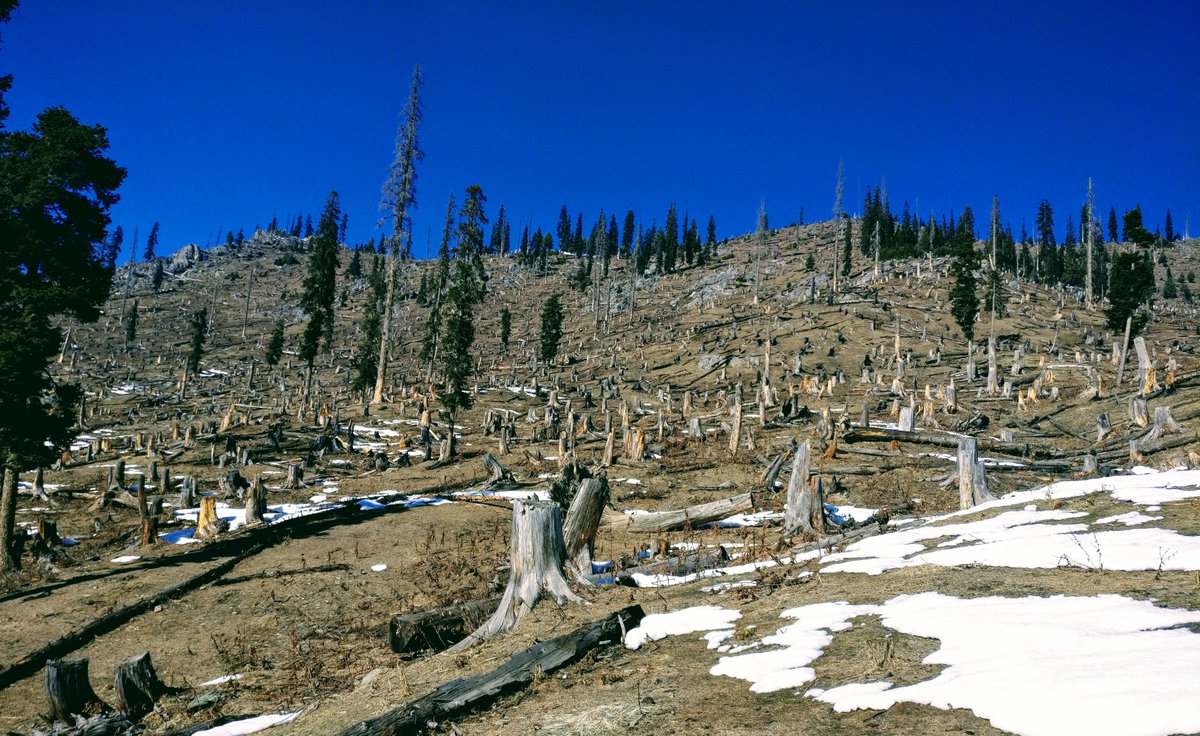By: Dr. Showkat Rashid Wani
The United Nations General Assembly proclaimed 21 March the International Day of Forests in 2012 to celebrate and raise awareness of the importance of all types of forests.
The Directorate of Distance Education had deputed some of its students to MET Higher Secondary School for Practice of teaching. During inspection the author of this article saw a creative sketch on forest degradation by one of the students.
The student had got an idea from the CBSE Class 9 English Beehive book of her cousin containing a poem titled “On Killing a Tree”. She had written a beautiful summary of this poem in her own words, contextualizing it with her native environment.
The poem depicts a clear picture of man’s cruelty towards trees. The poet states that trees are living things, and we should not cut them. Destroying a tree is like killing a human being.
A tree does not die by just chopping and cutting. It grows again from where it has been cut. It only dies when it is uprooted from the ground.
The poem shows the destructive nature of humans and the indestructibility of nature. Trees are part and parcel of growing up. Budding scholars dream of fairies and deep woods as children’s literature across cultures is built on trees, creatures and mysteries of the forest.
Forests are not just indicators of a good environment but also augment the social and cultural well-being of people. Who can forget such characters as Alice from Alice’s in Wonderland (1865) and Winnie the Pooh (1926) or even Little Red Riding Hood (1812) forests have been depicted in various ways, thus enriching the cultural capital.
We must preserve them at every cost. Extensive research demonstrates that use of forests contributes to reducing stress and promoting more positive moods and feelings. In children, forests help to get healthy mental and social development.
For last couple of years I have visited several forest areas in different districts like Shopian, Bandipora, Ganderbal, where it is heart wrenching that deforestation has taken place at very large quantum and forests looks deserted. The wanton loot of green wealth continues to remain “unabated”.
The Directorate of Distance Education University of Kashmir offers 2 year BEd programme through Distance Mode. In one of the semesters “Environmental Education” is one of the core papers. The author of this article was taking supplementary online classes in Environmental Education on Google meet platform for the pupil teachers registered through Study –cum-Information Center Government Degree College Shopian. The topic in e-discussion forum was “How to save the forests of district Shopian”.
Students raised lot of environmental concerns on their respective WhatsApp groups. These concerns were substantiated by sharing relevant reports and photographs which depicted deforestation of the area.
During these brainstorming sessions students shared their experience that those forests of Shopian which are near municipal areas are more vulnerable because there is a huge demand for timber.
A chain of people are involved from cutting trees to selling in the market. The structural damage of forests is a three tier process.
At the level one is the local wood-cutter who lives in the forest fringe village. At level two is the transporter who is either a horse or pony rider, head loader or mini or large carriages.
At the level three is the joinery or band-saw where sleepers are crushed and converted into finished goods for sale in the market.
On pilot basis pupil teachers of district Shopian under the supervision of the author of this article conducted a series of awareness activities for local wood-cutters, transporters, band saw owners and workers, forest guards regarding the importance of forests from social and religious perspective.
These people were educated in the mother language supported with relevant pictures and videos that due to human-induced- deforestation the wild –life ecosystem has been disturbed. Every day we hear incidents of man-animal conflict.
During this interaction one of the wood-cutters admitted that our miseries are self-afflicted. He cited an example how his child was gravely injured by a leopard while he was busy felling the trees.
The counseled group of local population realized that wild animals need suitable accommodative environment where they will feel safe, thrive and move undisturbed. The student counselors added that forests are used by wild animals for resting, breeding, hiding and escaping predators.
But when these habitats are exposed, wild animals lose access to important resources; they get psychologically disturbed and display abnormal behavioral dispositions due to loss of natural habitats.
They are forced to move out of their natural habitats which result in man-animal conflict. The list of threatened species of animals and birds is increasing day by day. Practically, all watersheds in J&K state are deforested heavily.
For example the Siwaliks Kandi which was once full of forest trees, has now become a vast desert; it is also in the grip of water famine. At the conclusion of the counseling process the stakeholders assured the student counselors to work as good ambassadors for saving forests.
Recommendations:
1. The people living in the forest fringe villages who indulge in wood cutting belong to Socio-economically-disadvantaged-groups (SEDG) . As per NPE 2020 these marginalized group lack access to quality education, health and better employment opportunities. With no alternative employment opportunity around they resort to deforestation activities for a small amount. These people need to be rehabilitated to safer zones and provided an alternative employment opportunities in forest resurrection and conversation sector.
2. The forest department should involve local population in afforestation activities like mass plantation drive. This activity need to be incentivized for roping larger masses in this renewal process. Mass planting drive should be launched on the lines of foreign countries as we have lot of vacant waste lands for reforestation.
3. In vulnerable and smuggling prone areas forest department should develop tracking routes and eco-parks which will facilitate the generation of employment opportunities for the local population.
4. The chronic and habitual timber smugglers need to be identified through local support and technological intervention and booked under public safety acts (PSA). This deterrent measure will create fear psychosis among the potential offenders.
5. Orientation/ Refresher programmes should be organized for forest protection forces to train them in carrying out the scientific investigations in forest crime cases. As a deterrent case studies of officials caught red handed by crime department in corruption cases were shared with forest officials.
6. The objective investigations in forest crime cases will help the police to expose the nexus of criminals who facilitate illicit timber trade.
7. Development projects identify roads to be constructed through the middle of the forests should revisit their architectural designs and try to construct roads outside the boundary walls of the forests. Forest Advisory Committee of the state of Jammu and Kashmir should give official clearances to projects if they do not disturb the fragile ecosystem of our forests.
8. The forest department should identify the band-saw owners involved in illicit timber trade, penalize and seal their machines.
9. The monitorial wing of forest protection squad should regularly check the suspicious movement of the vehicles especially during night hours, those vehicles involved in illicit timber trade should be seized and their registration cancelled.
10. The grey areas which stand chronically degraded and deforested in the deep inner zone need to be identified. These grey areas need to be resurrected by mass plantation drive.
11. There has been lot of encroachments of forest zone areas. The revenue department should identify the encroached forest lands and free it from the clutches of encroachers. The LG administration under the dynamic leadership of Shri Manoj Sinha deserves acknowledgment and appreciation for retrieving thousands of Kanals of state forest land from encroachers.
12. Fencing of forest zones at vulnerable areas should be taken at top priority. Past experiences reveal that plantation drives launched by the Department of Forest, Environment and Ecology and erecting; fencing of forests has checked the rampant feeling of trees by timber smugglers.
13. A strong check through installation of CCTV cameras in the interiors of forests should be taken on priority. Those horses used in illicit timber trade should be seized and penalty imposed on their owners.
14. Department of Forests, Ecology and Environment in collaboration with grass root level institutions like schools, colleges should generate mass awareness regarding the role of forest cover in human lives.
15. Forests face enormous anthropogenic pressure as they provide diversified services. This pressure is further catalyzed by forest fires which pose a grave threat to native flora, fauna and adversely disturbs the ecosystem equilibrium. The precautions reflected in a report released by Department of Forests, Ecology and Environment titled “Forest fire risk zonation and vulnerability assessment of J&K forests” need to be implemented in letter and spirit.
16. Keeping in view the interests of our forest wealth people should drop the idea of constructing hamams and wood paneling in homes.
17. Agroforestry refers to the practice of combining agriculture and forest activities so it provides food, fodder, fuel, fiber and fertilizers which are primary needs of the farmers. Thus, setting up of agroforestry practice in the villages will make villagers self-reliant in their primary needs of fuel, fodder, food as well as timber so that they do not resort to forest damage. Social forestry was meant for this self sufficiency of the rural population.
18. Soil erosion occurs due to depletion of forests. Deforestation causes soil erosion and floods, and these in turn cause further damage to forest resources. The Himalayan region including Jammu and Kashmir is most eroded and a flood of the northern India is the result of deforestation of the Himalayas. Top rich fertile soil that supports vegetation has since been washed away and what is left behind is the infertile mass with coarse texture. This requires heavy manuring to obtain good produce in agriculture including that of fruits, vegetables and forest products.
19. Over use, abuse and misuse of the forests particularly of alpine pastures which stand overgrazed by the livestock have become degraded badly. Similarly, the traditional important Dachigam’s pasture lands are under high grazing and consequently suffer from soil erosion. This needs to be checked.
To conclude, forests are our nerve centers. As the lifeblood of human existence, forests provide shelter to several species of plants, animals and insects. Water bodies survive and remain perennial if forests remain alive and throbbing. So integral is the existence of a forest for ecological well-being that it led a fifteenth-century Kashmiri poet Sheikh ul Alam to observe thus: “Ann poshi teli yeli wan poshi”, meaning “food will last as long as forests last.”
DISCLAIMER: The views and opinions expressed in this article are the personal opinions of the author. The facts, analysis, assumptions and perspective appearing in the article do not reflect the views of KIF.






